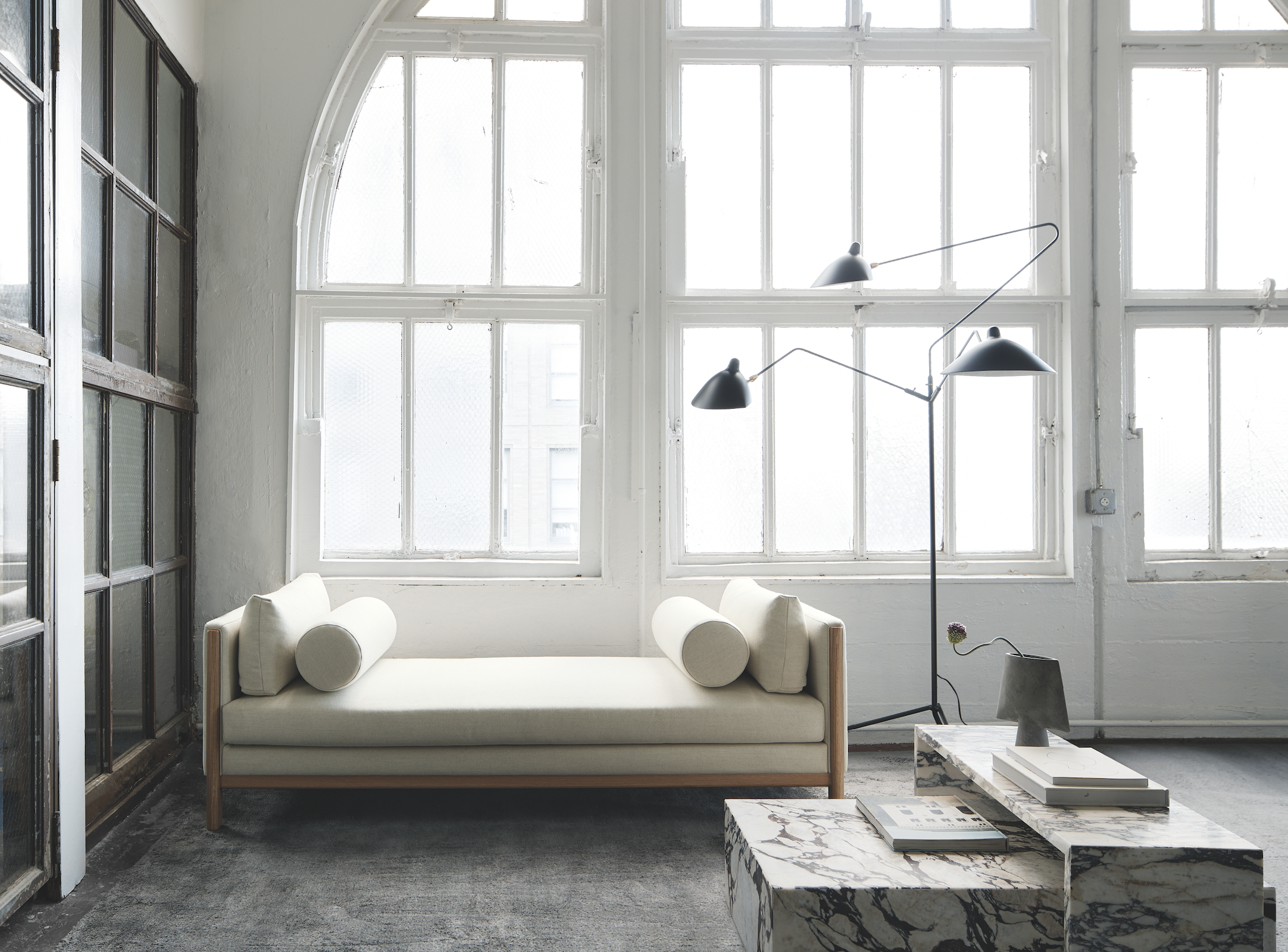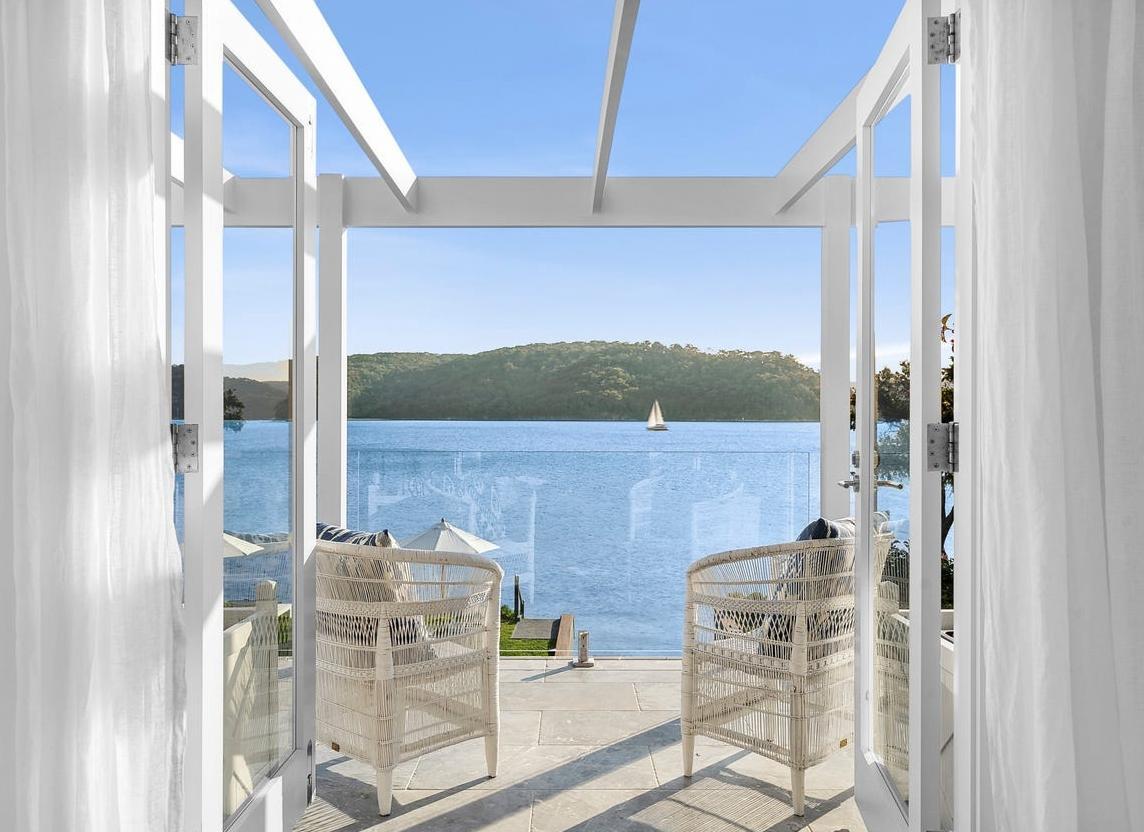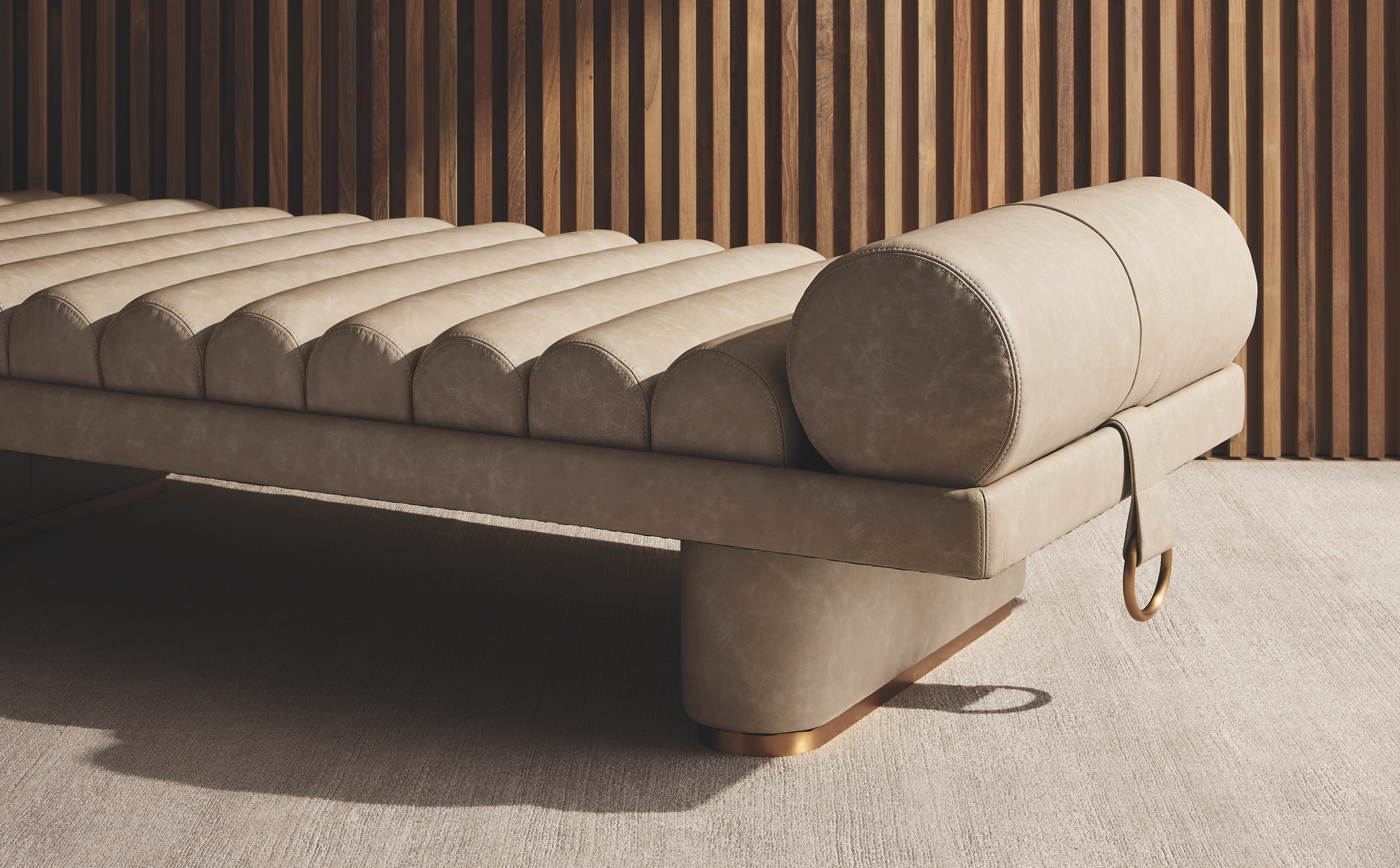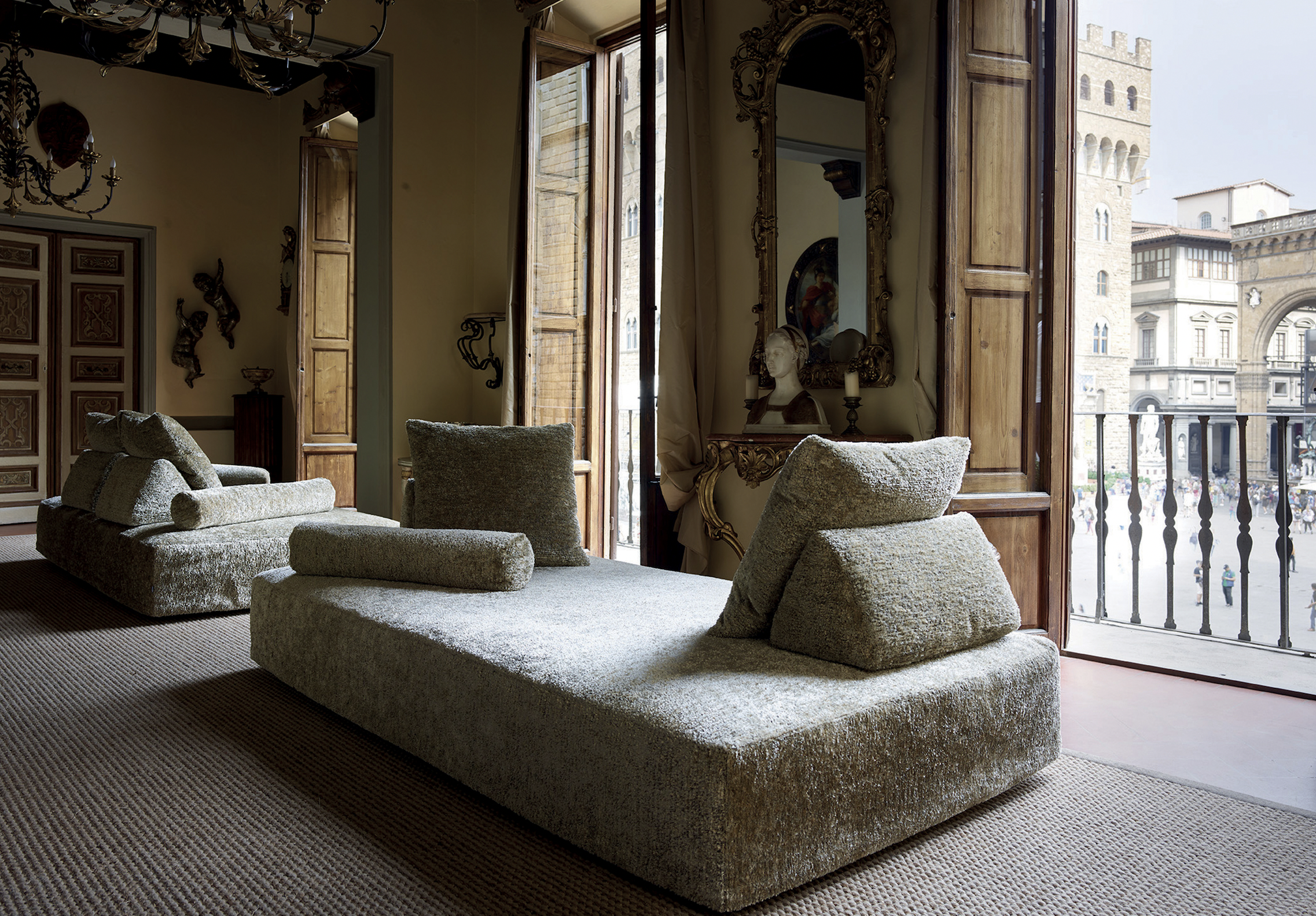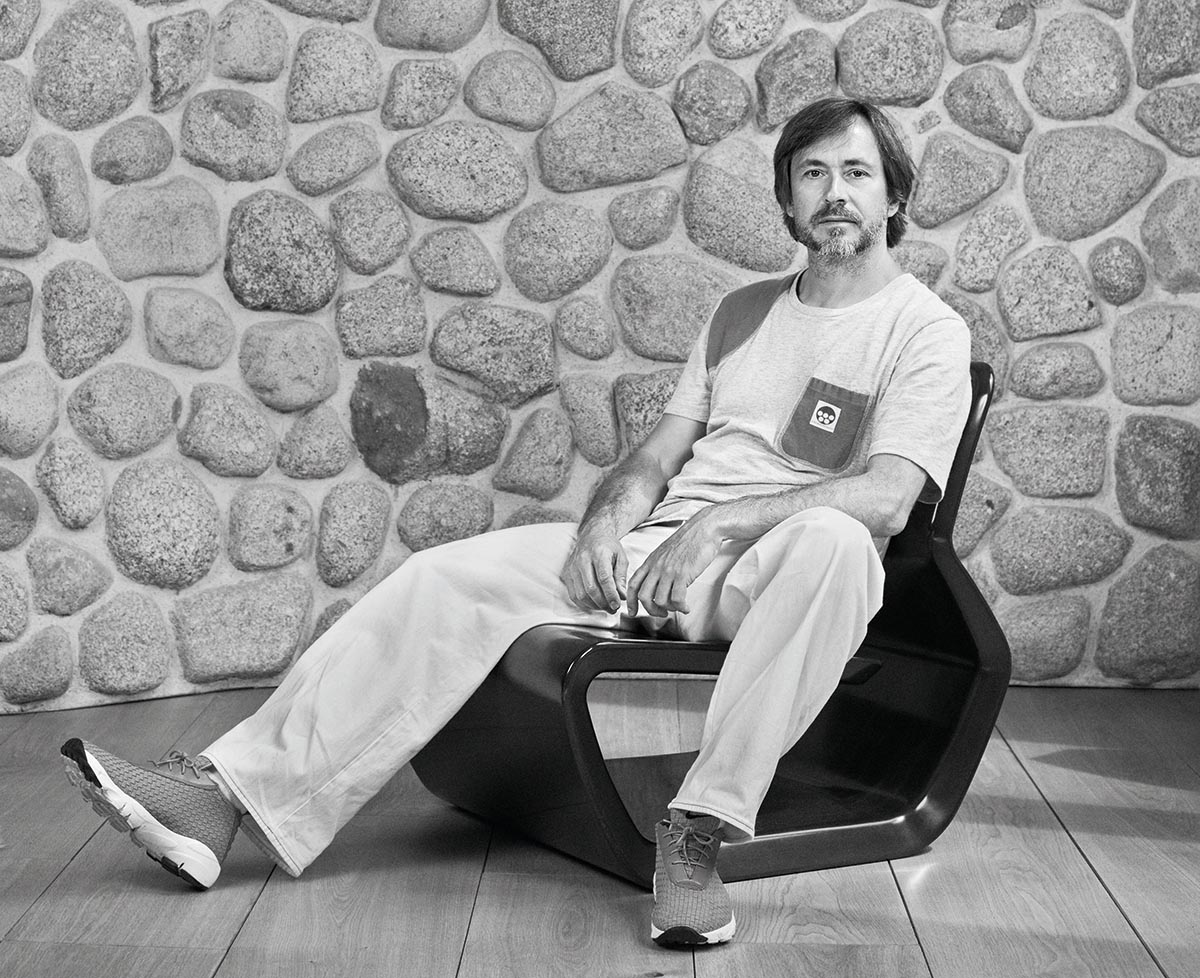
Robb Read: Australian Designer Marc Newson
Newson reflects on the changing world, designing for the one per cent and what the future holds.
Related articles
“Fundamentally, my job is problem-solving. Designing always boils back to the fact you’re solving problems,” says Marc Newson, explaining his role as a designer with fingers in many, many pies.
“You’re a gun for hire. A troubleshooter. Why are you doing it otherwise? The reason you do this is you’re either dissatisfied with the way things are or something needs to be improved. So clearly, my job relies on the reality that there is a degree of dissatisfaction and an unworthiness in products out there. If everything was perfect, I’d be out of a job.”
As one of the world’s most influential modern industrial designers, it’s much easier to list what the Sydney-born, UK-based designer’s Midas pen has not touched in his pursuit of perfection. His oeuvre spans furniture, jewellery, luggage, aviation, timepieces, interiors, homewares, marine, footwear, technology and aerospace. His client list includes Louis Vuitton, Hermès, Nike, Hennessy, Dom Pérignon, Jaeger-LeCoultre, Georg Jensen, R.M Williams and Riva; and his CV reads creative director of Qantas and special projects designer for Apple (where he helped design the Apple Watch).
Newson’s most famous pieces are arguably the Lockheed Lounge, Embryo Chair and Ikepod watch. The latter is a cult-status watch company he co-founded in 1994 and departed in 2012—a disappointing victim of a lack of resources more than anything, he says.
“The Ikepod was an unmitigated commercial failure, but the fact that the watchband lived on in the Apple Watch is an indication it wasn’t the product that was at fault,” he shrugs.
The company has been recently resurrected by its new owners, without Newson or his cofounder Oliver Ike. Blurring the line between art and design, Newson is the only designer to be represented by the contemporary art heavyweight Gagosian Gallery; and his work sits in the collections of National Gallery of Victoria, The Museum of Modern Art, San Francisco Museum of Modern Art, V&A Museum, Musée National d’Art Moderne, Centre Pompidou, Vitra Design Museum, Israel Museum and Musée des Arts Décoratifs. If you don’t know him by name, you will surely know the 56-year-old visionary by design.

The day we speak, the United Kingdom, which has been Newson’s home since 1997, has been on COVID-19 lockdown for mere weeks. The designer is holed-up in the rural splendour of the Cotswolds district, attempting to work from home across his own design studio and LoveFrom, a new and super-hyped design firm co-founded with friend and former Apple design chief Jony Ive.
“It’s been fantastic because it’s given us a moment to breathe,” he says of launching the latter amid global chaos. “There was a point where opportunities were piling up, and I don’t mean to sound ungrateful but [recent events] have provided a really interesting opportunity to reflect on what’s important.”
Newson labels himself a pro-multitasker, but also admits he’s never known any other way. “Thankfully, nothing has been cancelled, but some things have been slowed. Honestly, for me in my current situation, that’s welcome respite from the usual frenetic, nonstop pressure.”
We’re speaking while he’s on an ‘essential’ run, stretching the legs of his vintage Aston Martin DB4. The Aston, as it turns out, had a flat battery that resulted in him needing to be rescued by a family member, and a return phone call. An inconvenience to Newson, but a forgivable one because the DB4 is, after all, one of the most beautiful Aston Martins ever created—and one of many classics that make up his car collection.
“I have a bunch of old sports cars—Bugattis, Astons, Ferraris and Alfas,” he says. “The DB4 is one of the more drivable cars I have… well, usually,” he says, laughing. “I’ve had it for a long time—I bought it with my very first pay cheque.”
Such chatter brings us to the subject of modern car culture. As a vintage car lover, bona fide problem solver and one-time car designer (a concept for Ford in 1999), how does he feel about the EV-olution?
“I’m not much of a modern car person,” he offers. “Obviously it’s good that emissions are being reduced, but I’ve been quite vocal about electric vehicles—I’m just not convinced they fundamentally address the problem. I would much rather have seen the fuel cell championed—that’s far more sustainable.”
Newson has been an outspoken critic of modern automotive design for some time (“It’s sort of gratuitous”) though he also owns a couple of contemporary cars, including a Range Rover that he accepts may be a cliché, but is innocuous design-wise.
“For me, there’s a world of difference between older cars and new cars. I mean, they kind of have nothing to do with each other, really, in my mind. The values that I respond to in older cars. It’s like anything, if something is well-made and not inherently disposable, it’s just far more sustainable by nature.”
Despite attending art school in the mid-’80s, Newson found himself gravitating towards design. He insists there was not one moment where he felt he was on the road to fame—rather, a trail of toil that saw him work in Japan, Italy and Paris, the latter where he eventually set up a studio.
Even so, Newson’s curved, futuristic designs came to define the aesthetic of the late-’90s and early-’00s. “It’s much easier to see in retrospect,” he says, retaining a nuanced Australian accent.“
At the time, you’re so immersed in it, you don’t see the forest for the trees… But yes, now and again I have the opportunity to sit back and look at [earlier] stuff.”
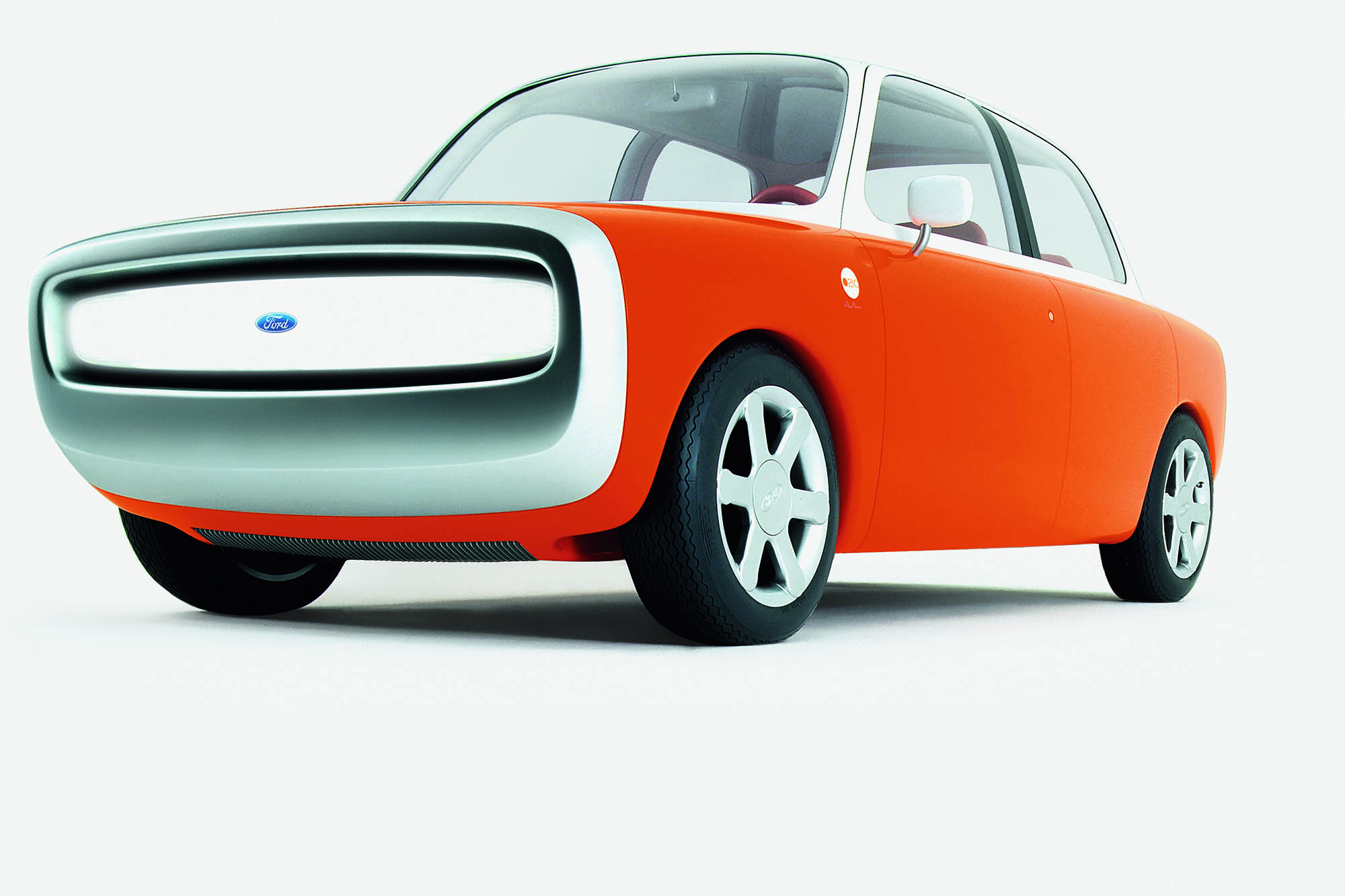
He points to his work with Ford on its strikingly fun 1999 concept car. “I’m constantly reminded by people both in the automotive industry and outside of it, about how contemporary it is, which is a great compliment.”
Indeed, the now 21-year-old Ford 021C would easily rival the hype-filled new Honda E on several fronts, not least its unique sense of charm.
Line up the big hitters of the last century—from Le Corbusier to Dieter Rams, Florence Knoll Bassett to Zaha Hadid—and often a designer’s success isn’t defined by their time, but their outlook on it. Newson doesn’t design for the now, he designs for the future.
“I’ve been working on an office chair now for like, seven years,” he sighs. “It’s completely and utterly insane. It shouldn’t take that long! But it’s not unheard of for some projects to take five years. So you need to be able to look to the future—if you can’t, then everything you do will be obsolete by the time it reaches the public.”
The world being in a state of current uncertainty begs the question: how does he troubleshoot for global flux?
“You just ignore the pace at which things are changing,” he says. “I don’t think about it. You can’t. If you do, you’ll be dumbstruck.”
Newson, who talks in what seems like a long series of ellipses, takes a lengthy pause. “Anyway, even though things are moving so quickly—and I’m not talking about tech, I’m talking about aesthetics—fundamental values always hold true.”
His formula, he eventually offers, is simple: do things at his own pace, on his terms, sticking to his guns. “You have to be mindful of the world we live in but not get bogged down by it,” he says.
The tales of Apple’s inner-utopia have become the stuff of legend, especially among the design and tech communities, and Newson does nothing to shatter the myth. From the beginnings of their partnership at Apple, Newson says he and Ive had a synchronistic way of working—a philosophy that they will carry into LoveFrom (the company’s name itself is a nod to Steve Jobs’ from-the-heart creative ethos).
Indeed, a lot of it comes from a common problem-solving attitude, but also, Apple gave its team the freedom to work as such.
“With Apple, more than an aesthetic, it was a philosophy,” Newson says of working with the tech giant. “Things are done in a very singular way. Problems and goals are identified early on and constraints don’t become the parameter that dictate the way something is brought to market. If a piece of kit doesn’t exist, they will simply invent it, the production line that goes with it and the economy that surrounds it.”
This is not how most companies work.
“Industry generally works in a far more reactive way… It’s a bit like trying to figure out a better way to mend a flat tyre when you’d be better off just rethinking the wheel, so you never had flat tyres.”
Right now it’s hard to talk about manufacturing without exploring the notion of sustainability—a term that Newson finds as irritating as “wearable” and, well, “luxury”.
“It’s just become this blanket term that has found its way into our language,” he says. “There are a million aspects to sustainability. Material sustainability, philosophical sustainability and the whole question of obsolescence… I’d like to think that I’m designing things that are not designed for landfill. That’s the worst demonstration of everything bad about our society, in terms of consumption.”
He adds: “I think for people like me, for designers to create great things, industry needs to get on board or to evolve in a way like Apple did. Where design and industry have completely, I believe, meshed.”
Granted, Newson’s biggest critics all seem to have the same issue with his work: it’s designed for the one per cent, the privileged. Jet pack prototypes, million-dollar chairs, special-edition fountain pens, speedboats—he’s even designed a $38,000 shotgun for Beretta, named the 486 by Marc Newson. But he argues that the elite have a conscious for craftmanship.
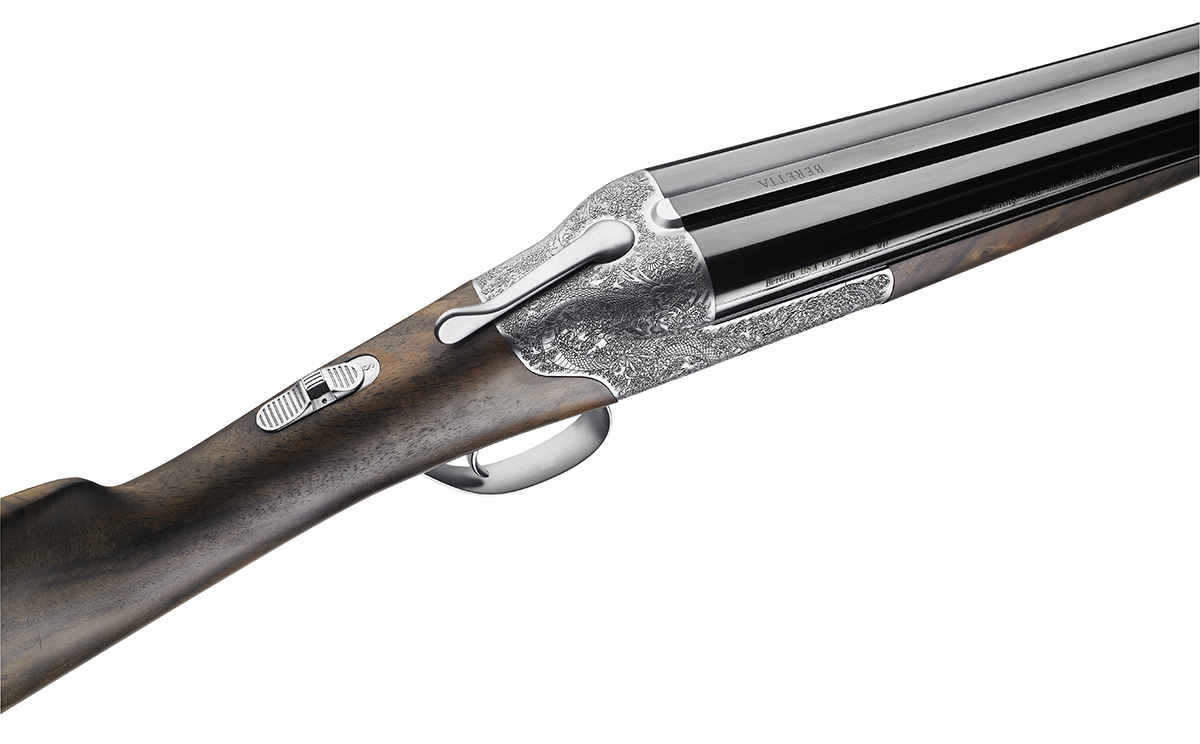
“Take the role of the Louis Vuitton luggage that I’ve designed. One of the really interesting things, and one of the reasons I respond positively to working with companies like that, is that everything they make is repairable. The alternative would be to design for some company that mass produces things, makes them far more accessible to the general population, but far worse for the environment because they simply can’t be repaired and end up on a rubbish pile.”
Newson recalls a quote from former Hermés CEO Jean-Louis Dumas (‘It’s not expensive, it’s costly; there’s a big difference’) before revealing that two megayachts he recently designed are being built.
Newson believes they could end up being among the biggest in the world, at least in terms of tonnage.
“It’s easy to poo-poo an oligarch who spends half a billion on a boat,” he offers. “But the reality is, as absurd as that is, it provides livelihoods for many, many thousands of fine craftspeople and enables fine crafts and engineering expertise that would cease to exist otherwise.”
There are many arguments about the role of design, or rather, what defines ‘good design’. For some, it’s form met with equal function; for others, that balance is asymmetrical. In
Newson’s case, being art-trained has sometimes meant his works blur the lines. Like his beloved DB4, they’re not always highly functional, but their beauty endures.
Take his famous Lockheed Lounge, which holds the record for the most expensive design object sold at auction (securing $4.69 million in 2015). Newson will readily admit that it’s not the plushest of chairs—but if you’re looking at his work through the same lens as a La-Z-boy, then it’s not for you.
“I’m designing sculpture or furniture or whatever you want to call it,” he says of his niche. “You can sit on these things. I don’t discourage people to sit on these things,
but they’re not much more comfortable than a bus stop. They have a function, but their primary function is not that. They have a different function.”
Newson is from the school of thought that design, at the very least, should provide choice. “One of the things that I love about design, it’s not like architecture in the sense that it’s imposed upon you,” he says. “If
you have to go to a certain building to work every day, and you hate it, there’s not a hell of a lot that you can do about it. Design has a much greater ability—you can either take it or leave it.”
This piece is from our new Design Issue – on sale now. Get your copy or subscribe here, or stay up to speed with the Robb Report weekly newsletter.
Subscribe to the Newsletter
Recommended for you
5 Lounge Chairs That Add Chic Seating to Your Space
Daybeds, the most relaxed of seating solutions, offer a surprising amount of utility.
July 22, 2024
Living La Vida Lagerfeld
The world remembers him for fashion. But as a new tome reveals, the iconoclastic designer is defined as much by extravagant, often fantastical, homes as he is clothes.
July 22, 2024
You may also like.
By Josh Bozin
24/07/2024
You may also like.
5 Lounge Chairs That Add Chic Seating to Your Space
Daybeds, the most relaxed of seating solutions, offer a surprising amount of utility.
Chaise longue, daybed, recamier, duchesse brisée—elongated furniture designed for relaxing has a roster of fancy names. While the French royal court of Louis XIV brought such pieces to prominence in fashionable European homes, the general idea has been around far longer: The Egyptian pharaohs were big fans, while daybeds from China’s Ming dynasty spurred all those Hollywood Regency fretwork pieces that still populate Palm Beach living rooms. Even Mies van der Rohe, one of design’s modernist icons, got into the lounge game with his Barcelona couch, a study of line and form that holds up today.
But don’t get caught up in who invented them, or what to call them. Instead, consider their versatility: Backless models are ideal in front of large expanses of glass (imagine lazing on one with an ocean view) or at the foot of a bed, while more structured pieces can transform any corner into a cozy reading nook. Daybeds may be inextricably linked to relaxation, but from a design perspective, they put in serious work.
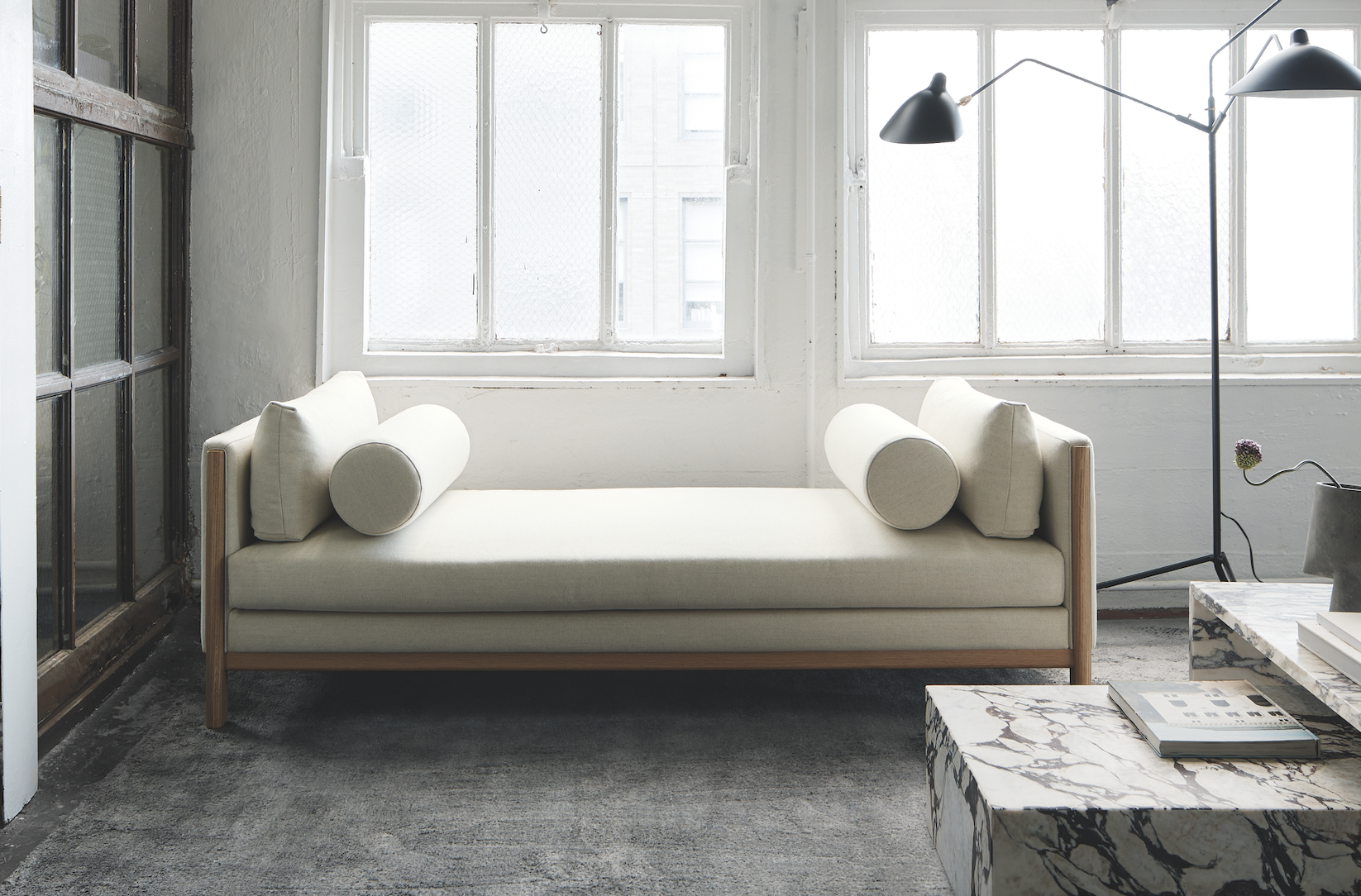
Emmy, Egg Collective
In designing the Emmy chaise, the Egg Collective trio of Stephanie Beamer, Crystal Ellis and Hillary Petrie, who met as students at Washington University in St. Louis, aimed for versatility. Indeed, the tailored chaise looks equally at home in a glass skyscraper as it does in a turn-of-the-century town house. Combining the elegance of a smooth, solid oak or walnut frame with the comfort of bolsters and cushioned upholstery or leather, it works just as well against a wall or at the heart of a room. From around $7,015; Eggcollective.com
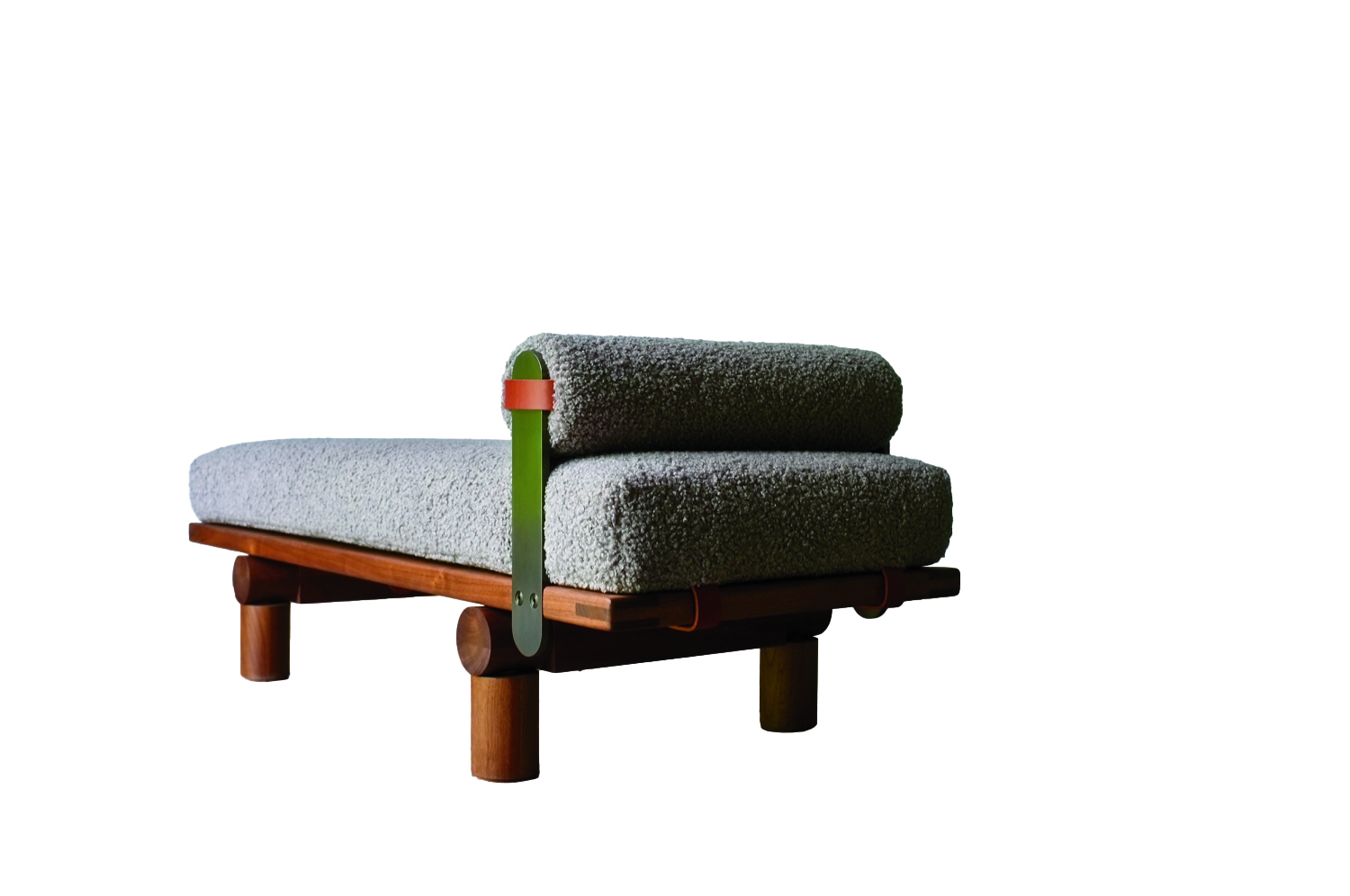 Plum, Michael Robbins
Plum, Michael Robbins
Woodworker Michael Robbins is the quintessential artisan from New York State’s Hudson Valley in that both his materials and methods pay homage to the area. In fact, he describes his style as “honest, playful, elegant and reflective of the aesthetic of the Hudson Valley surroundings”. Robbins crafts his furniture by hand but allows the wood he uses to help guide the look of a piece. (The studio offers eight standard finishes.) The Plum daybed, brought to life at Robbins’s workshop, exhibits his signature modern rusticity injected with a hint of whimsy thanks to the simplicity of its geometric forms. Around $4,275; MichaelRobbins.com
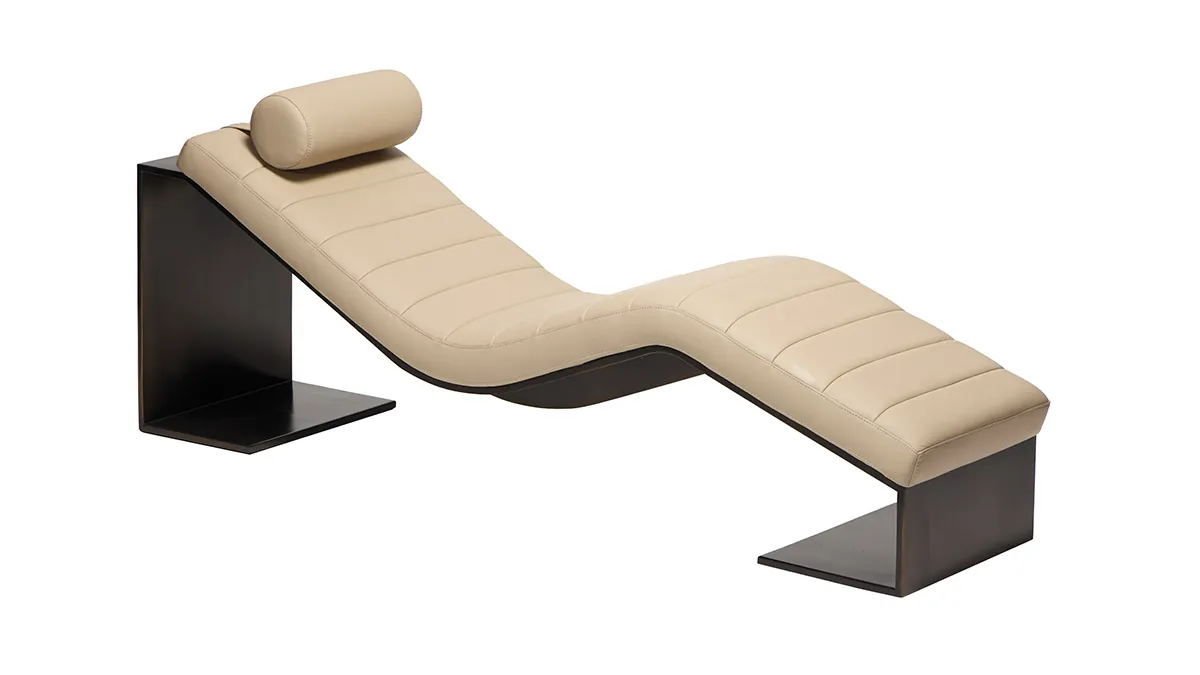
Kimani, Reda Amalou Design
French architect and designer Reda Amalou acknowledges the challenge of creating standout seating given the number of iconic 20th-century examples already in existence. Still, he persists—and prevails. The Kimani, a bent slash of a daybed in a limited edition of eight pieces, makes a forceful statement. Its leather cushion features a rolled headrest and rhythmic channel stitching reminiscent of that found on the seats of ’70s cars; visually, these elements anchor the slender silhouette atop a patinated bronze base with a sure-handed single line. The result: a seamless contour for the body. Around $33,530; RedaAmalou
Dune, Workshop/APD
From a firm known for crafting subtle but luxurious architecture and interiors, Workshop/APD’s debut furniture collection is on point. Among its offerings is the leather-wrapped Dune daybed. With classical and Art Deco influences, its cylindrical bolsters are a tactile celebration, and the peek of the curved satin-brass base makes for a sensual surprise. Associate principal Andrew Kline notes that the daybed adeptly bridges two seating areas in a roomy living space or can sit, bench-style, at the foot of a bed. From $13,040; Workshop/ APD
Sherazade, Edra
Designed by Francesco Binfaré, this sculptural, minimalist daybed—inspired by the rugs used by Eastern civilizations—allows for complete relaxation. Strength combined with comfort is the name of the game here. The Sherazade’s structure is made from light but sturdy honeycomb wood, while next-gen Gellyfoam and synthetic wadding aid repose. True to Edra’s amorphous design codes, it can switch configurations depending on the user’s mood or needs; for example, the accompanying extra pillows—one rectangular and one cylinder shaped— interchange to become armrests or backrests. From $32,900; Edra
You may also like.
By Josh Bozin
24/07/2024
22/07/2024
Watches & Wonders 2024 Showcase: Hermès
We head to Geneva for the Watches & Wonders exhibition; a week-long horological blockbuster featuring the hottest new drops, and no shortage of hype.
With Watches & Wonders 2024 well and truly behind us, we review some of the novelties Hermès presented at this year’s event.
—
HERMÈS

Moving away from the block colours and sporty aesthetic that has defined Hermès watches in recent years, the biggest news from the French luxury goods company at Watches & Wonders came with the unveiling of its newest collection, the Hermès Cut.
It flaunts a round bezel, but the case middle is nearer to a tonneau shape—a relatively simple design that, despite attracting flak from some watch aficionados, works. While marketed as a “women’s watch”, the Cut has universal appeal thanks to its elegant package and proportions. It moves away from the Maison’s penchant for a style-first product; it’s a watch that tells the time, not a fashion accessory with the ability to tell the time.
Hermès gets the proportions just right thanks to a satin-brushed and polished 36 mm case, PVD-treated Arabic numerals, and clean-cut edges that further accentuate its character. One of the key design elements is the positioning of the crown, boldly sitting at half-past one and embellished with a lacquered or engraved “H”, clearly stamping its originality. The watch is powered by a Hermès Manufacture movement H1912, revealed through its sapphire crystal caseback. In addition to its seamlessly integrated and easy-wearing metal bracelet, the Cut also comes with the option for a range of coloured rubber straps. Together with its clever interchangeable system, it’s a cinch to swap out its look.
It will be interesting to see how the Hermès Cut fares in coming months, particularly as it tries to establish its own identity separate from the more aggressive, but widely popular, Ho8 collection. Either way, the company is now a serious part of the dialogue around the concept of time.
—
Read more about this year’s Watches & Wonders exhibition at robbreport.com.au
You may also like.
22/07/2024
Living La Vida Lagerfeld
The world remembers him for fashion. But as a new tome reveals, the iconoclastic designer is defined as much by extravagant, often fantastical, homes as he is clothes.
“Lives, like novels, are made up of chapters”, the world-renowned bibliophile, Karl Lagerfeld, once observed.
Were a psychological-style novel ever to be written about Karl Lagerfeld’s life, it would no doubt give less narrative weight to the story of his reinvigoration of staid fashion houses like Chloe, Fendi and Chanel than to the underpinning leitmotif of the designer’s constant reinvention of himself.
In a lifetime spanning two centuries, Lagerfeld made and dropped an ever-changing parade of close friends, muses, collaborators and ambiguous lovers, as easily as he changed his clothes, his furniture… even his body. Each chapter of this book would be set against the backdrop of one of his series of apartments, houses and villas, whose often wildly divergent but always ultra-luxurious décor reflected the ever-evolving personas of this compulsively public but ultimately enigmatic man.
With the publication of Karl Lagerfeld: A Life in Houses these wildly disparate but always exquisite interiors are presented for the first time together as a chronological body of work. The book indeed serves as a kind of visual novel, documenting the domestic dreamscapes in which the iconic designer played out his many lives, while also making a strong case that Lagerfeld’s impact on contemporary interior design is just as important, if not more so, than his influence on fashion.

In fact, when the first Lagerfeld interior was featured in a 1968 spread for L’OEil magazine, the editorial describes him merely as a “stylist”. The photographs of the apartment in an 18th-century mansion on rue de Université, show walls lined with plum-coloured rice paper, or lacquered deepest chocolate brown in sharp contrast to crisp, white low ceilings that accentuated the horizontality that was fashionable among the extremely fashionable at the time. Yet amid this setting of aggressively au courant modernism, the anachronistic pops of Art Nouveau and Art Deco objects foreshadow the young Karl’s innate gift for creating strikingly original environments whose harmony is achieved through the deft interplay of contrasting styles and contexts.
Lagerfeld learned early on that presenting himself in a succession of gem-like domestic settings was good for crafting his image. But Lagerfeld’s houses not only provided him with publicity, they also gave him an excuse to indulge in his greatest passion. Shopping!
By 1973, Lagerfeld was living in a new apartment at Place Saint–Sulpice where his acquisition of important Art Deco treasures continued unabated. Now a bearded and muscular disco dandy, he could most often be found in the louche company of the models, starlets and assorted hedonistic beauties that gathered around the flamboyant fashion illustrator Antonio Lopez. Lagerfeld was also in the throes of a hopeless love affair with Jacques de Bascher whose favours he reluctantly shared with his nemesis Yves Saint Laurent.

He painted the rooms milky white and lined them with specially commissioned carpets—the tawny patterned striations of which invoked musky wild animal pelts. These lent a stark relief to the sleek, machine-age chrome lines of his Deco furnishings. To contemporary eyes it remains a strikingly original arrangement that subtly conveys the tensions at play in Lagerfeld’s own life: the cocaine fuelled orgies of his lover and friends, hosted in the pristine home of a man who claimed that “a bed is for one person”.
In 1975, a painful falling out with his beloved Jacques, who was descending into the abyss of addiction, saw almost his entire collection of peerless Art Deco furniture, paintings and objects put under the auctioneer’s hammer. This was the first of many auction sales, as he habitually shed the contents of his houses along with whatever incarnation of himself had lived there. Lagerfeld was dispassionate about parting with these precious goods. “It’s collecting that’s fun, not owning,” he said. And the reality for a collector on such a Renaissance scale, is that to continue buying, Lagerfeld had to sell.
Of all his residences, it was the 1977 purchase of Hôtel Pozzo di Borgo, a grand and beautifully preserved 18th-century house, that would finally allow him to fulfill his childhood fantasies of life in the court of Madame de Pompadour. And it was in this aura of Rococó splendour that the fashion designer began to affect, along with his tailored three-piece suits, a courtier’s ponytailed and powdered coif and a coquettish antique fan: marking the beginning of his transformation into a living, breathing global brand that even those with little interest in fashion would immediately recognise.
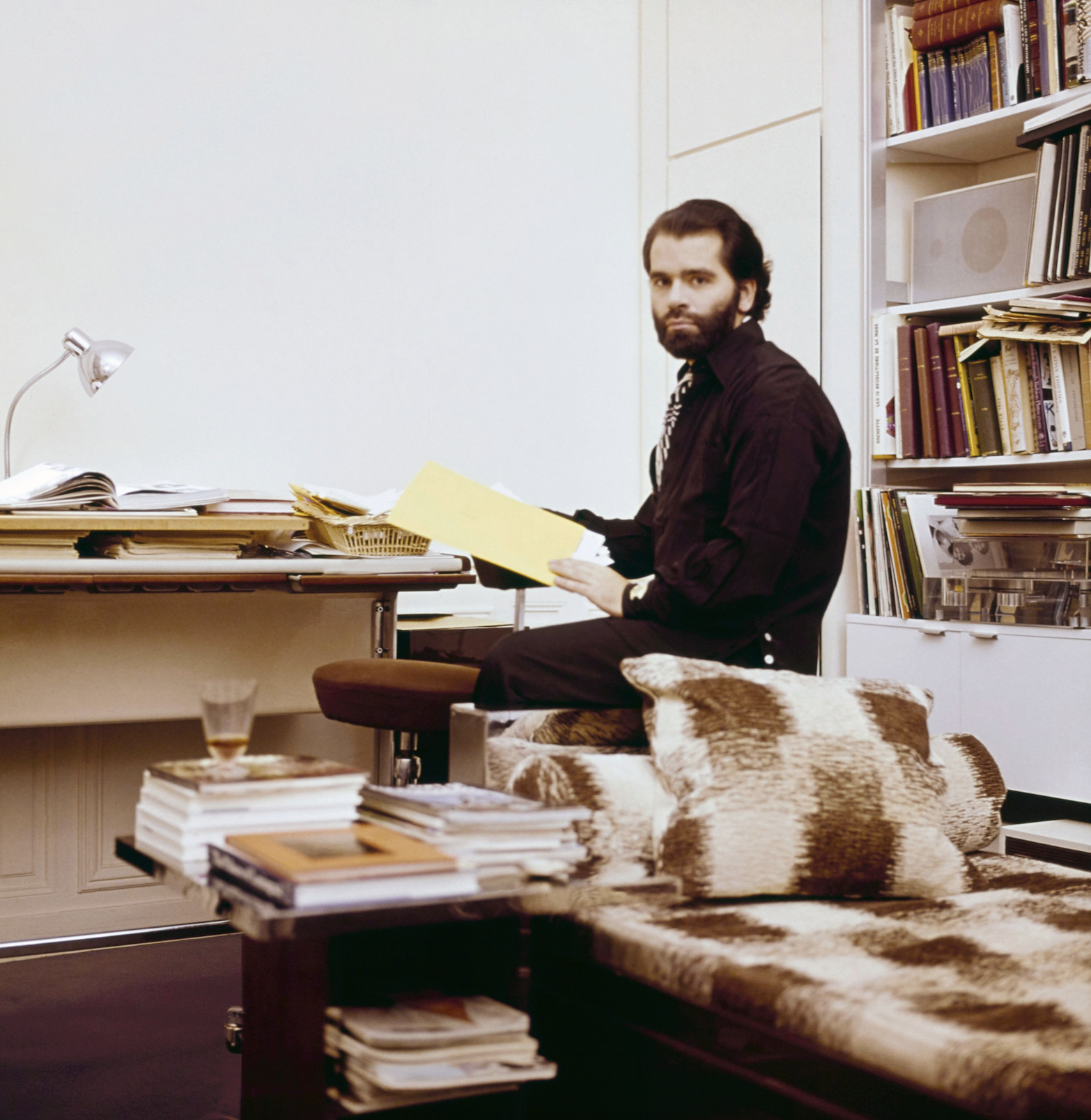
Lagerfeld’s increasing fame and financial success allowed him to indulge in an unprecedented spending frenzy, competing with deep-pocketed institutions like the Louvre to acquire the finest, most pedigreed pearls of the era—voluptuously carved and gilded bergères; ormolu chests; and fleshy, pastel-tinged Fragonard idylls—to adorn his urban palace. His one-time friend André Leon Talley described him in a contemporary article as suffering from “Versailles complex”.
However, in mid-1981, and in response to the election of left-wing president, François Mitterrand, Lagerfeld, with the assistance of his close friend Princess Caroline, became a resident of the tax haven of Monaco. He purchased two apartments on the 21st floor of Le Roccabella, a luxury residential block designed by Gio Ponti. One, in which he kept Jacques de Bascher, with whom he was now reconciled, was decorated in the strict, monochromatic Viennese Secessionist style that had long underpinned his aesthetic vocabulary; the other space, though, was something else entirely, cementing his notoriety as an iconoclastic tastemaker.
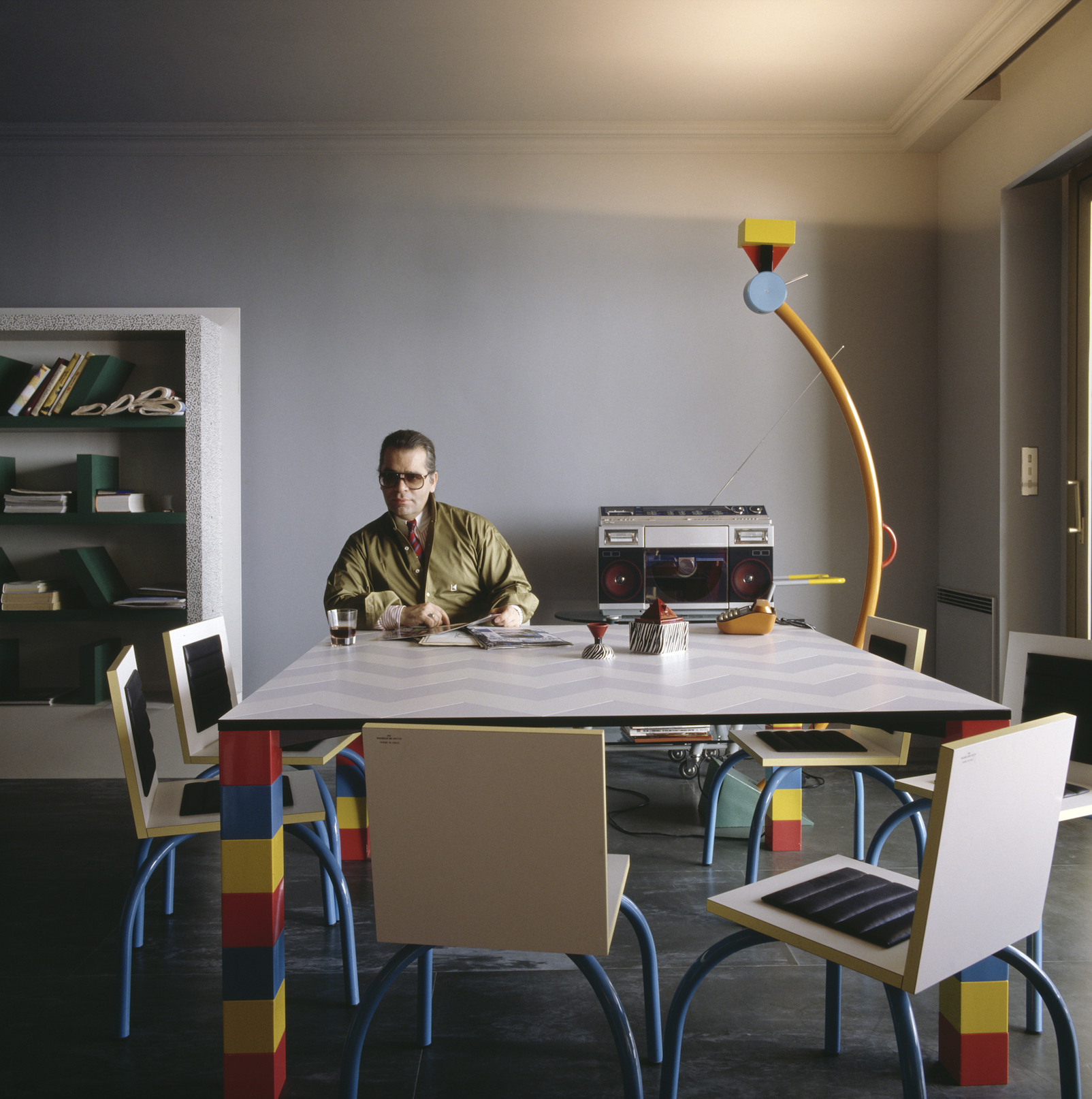
Lagerfeld had recently discovered the radically quirky designs of the Memphis Group led by Ettore Sottsass, and bought the collective’s entire first collection and had it shipped to Monaco. In a space with no right angles, these chaotically colourful, geometrically askew pieces—centred on Masanori Umeda’s famous boxing ring—gave visitors the disorientating sensation of having entered a corporeal comic strip. By 1991, the novelty of this jarring postmodern playhouse had inevitably worn thin and once again he sent it all to auction, later telling a journalist that “after a few years it was like living in an old Courrèges. Ha!”
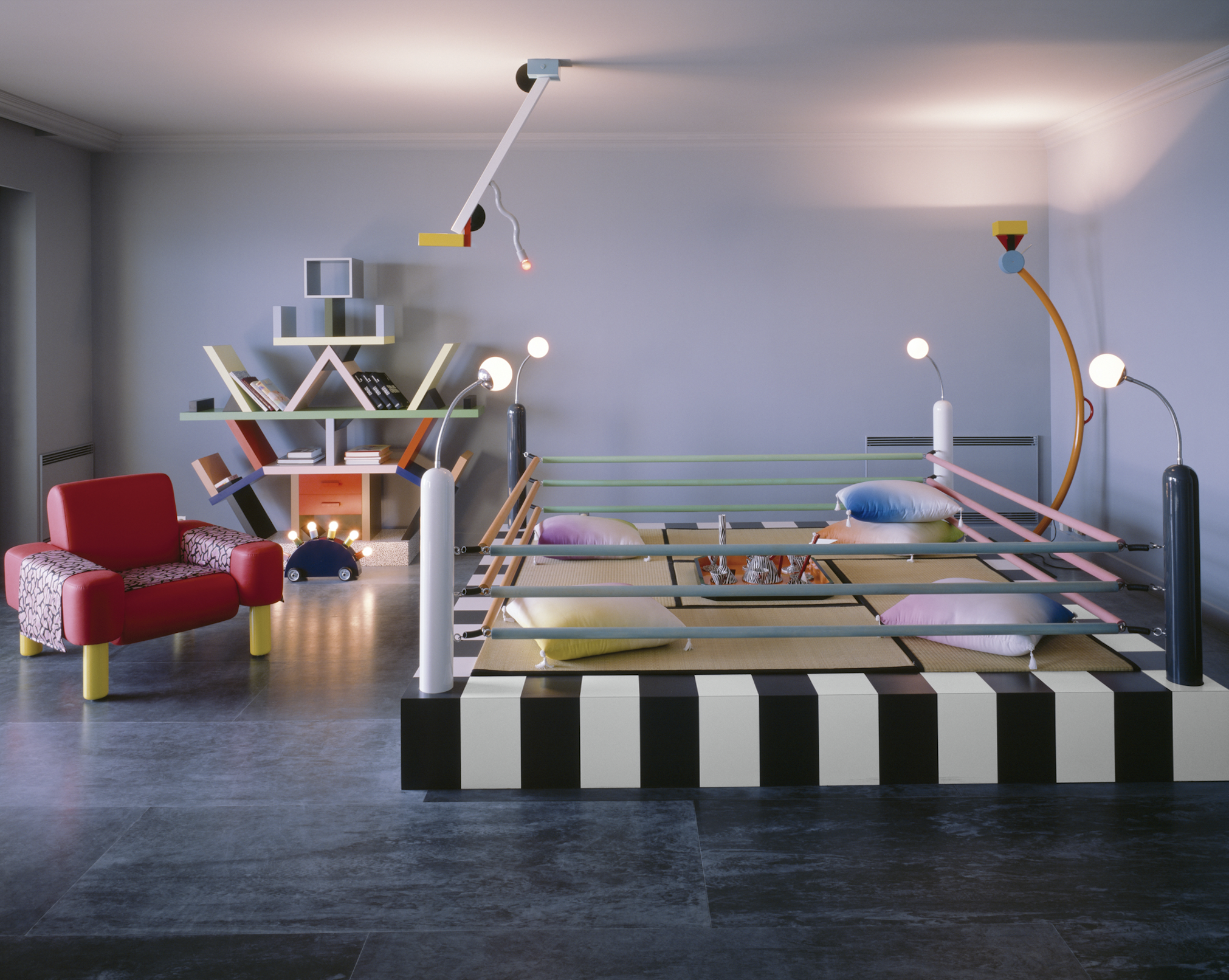
In 1989, de Bascher died of an AIDS-related illness, and while Lagerfeld’s career continued to flourish, emotionally the famously stoic designer was struggling. In 2000, a somewhat corpulent Lagerfeld officially ended his “let them eat cake” years at the Hôtel Pozzo di Borgo, selling its sumptuous antique fittings in a massive headline auction that stretched over three days. As always there were other houses, but now with his longtime companion dead, and his celebrity metastasising making him a target for the paparazzi, he began to look less for exhibition spaces and more for private sanctuaries where he could pursue his endless, often lonely, work.
His next significant house was Villa Jako, named for his lost companion and built in the 1920s in a nouveau riche area of Hamburg close to where he grew up. Lagerfeld shot the advertising campaign for Lagerfeld Jako there—a fragrance created in memorial to de Bascher. The house featured a collection of mainly Scandinavian antiques, marking the aesthetic cusp between Art Nouveau and Art Deco. One of its rooms Lagerfeld decorated based on his remembrances of his childhood nursery. Here, he locked himself away to work—tellingly—on a series of illustrations for the fairy tale, The Emperor’s New Clothes. Villa Jako was a house of deep nostalgia and mourning.
But there were more acts—and more houses—to come in Lagerfeld’s life yet. In November 2000, upon seeing the attenuated tailoring of Hedi Slimane, then head of menswear at Christian Dior, the 135 kg Lagerfeld embarked on a strict dietary regime. Over the next 13 months, he melted into a shadow of his former self. It is this incarnation of Lagerfeld—high white starched collars; Slimane’s skintight suits, and fingerless leather gloves revealing hands bedecked with heavy silver rings—that is immediately recognisable some five years after his death.
The 200-year-old apartment in Quái Voltaire, Paris, was purchased in 2006, and after years of slumber Lagerfeld—a newly awakened Hip Van Winkle—was ready to remake it into his last modernist masterpiece. He designed a unique daylight simulation system that meant the monochromatic space was completely without shadows—and without memory. The walls were frosted and smoked glass, the floors concrete and silicone; and any hint of texture was banned with only shiny, sleek pieces by Marc Newson, Martin Szekely and the Bouroullec Brothers permitted. Few guests were allowed into this monastic environment where Lagerfeld worked, drank endless cans of Diet Coke and communed with Choupette, his beloved Birman cat, and parts of his collection of 300,000 books—one of the largest private collections in the world.
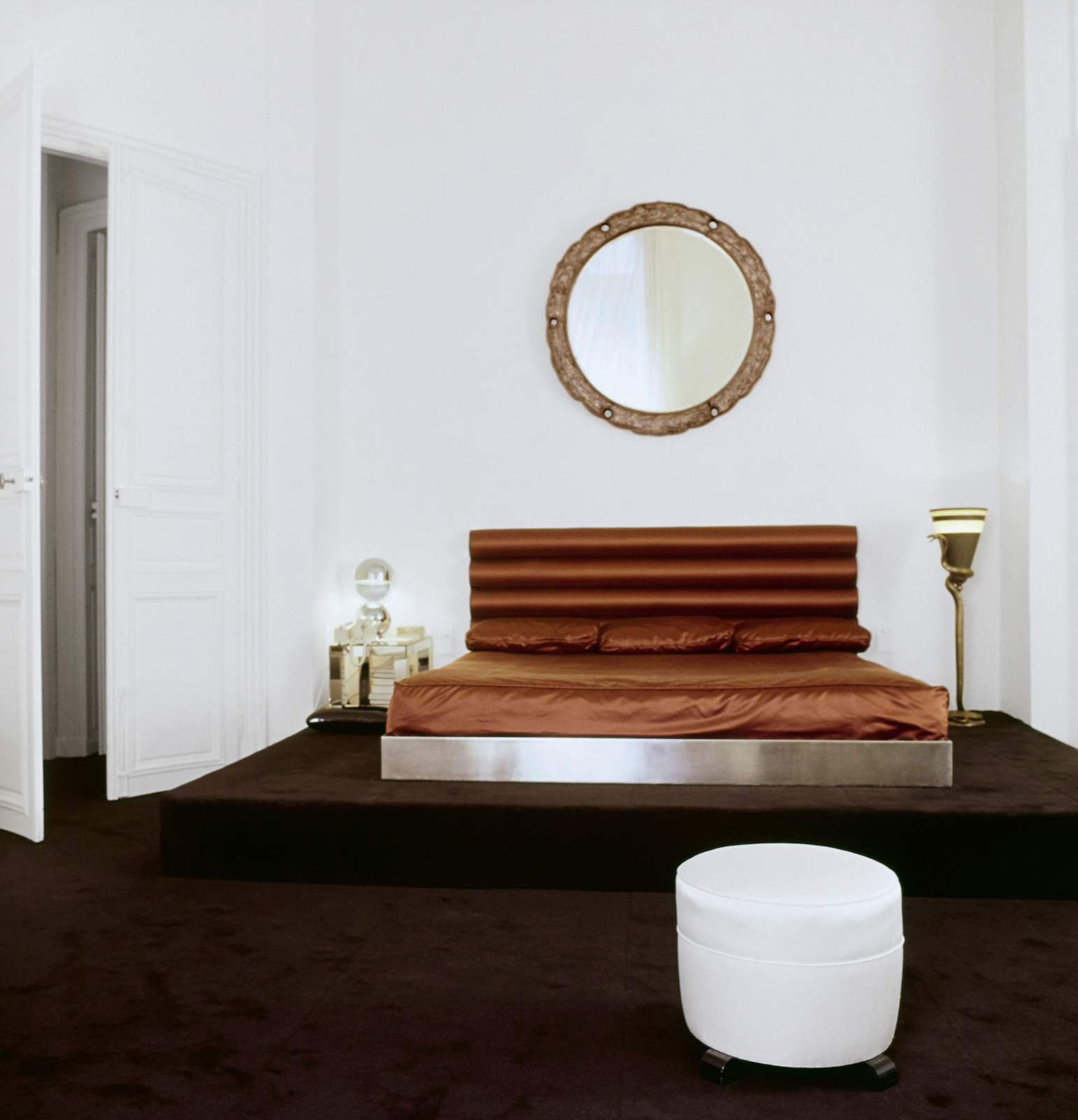
Lagerfeld died in 2019, and the process of dispersing his worldly goods is still ongoing. The Quái Voltaire apartment was sold this year for US$10.8 million (around $16.3 million). Now only the rue de Saint-Peres property remains within the Lagerfeld trust. Purchased after Quái Voltaire to further accommodate more of his books—35,000 were displayed in his studio alone, always stacked horizontally so he could read the titles without straining his neck—and as a place for food preparation as he loathed his primary living space having any trace of cooking smells. Today, the rue de Saint-Peres residence is open to the public as an arts performance space and most fittingly, a library.
You may also like.
By Josh Bozin
24/07/2024
Watch This Space: Mike Nouveau
Meet the game-changing horological influencers blazing a trail across social media—and doing things their own way.
In the thriving world of luxury watches, few people own a space that offers unfiltered digital amplification. And that’s precisely what makes the likes of Brynn Wallner, Teddy Baldassarre, Mike Nouveau and Justin Hast so compelling.
These thought-provoking digital crusaders are now paving the way for the story of watches to be told, and shown, in a new light. Speaking to thousands of followers on the daily—mainly via TikTok, Instagram and YouTube—these progressive commentators represent the new guard of watch pundits. And they’re swaying the opinions, and dollars, of the up-and-coming generations who now represent the target consumer of this booming sector.
—
MIKE NOUVEAU
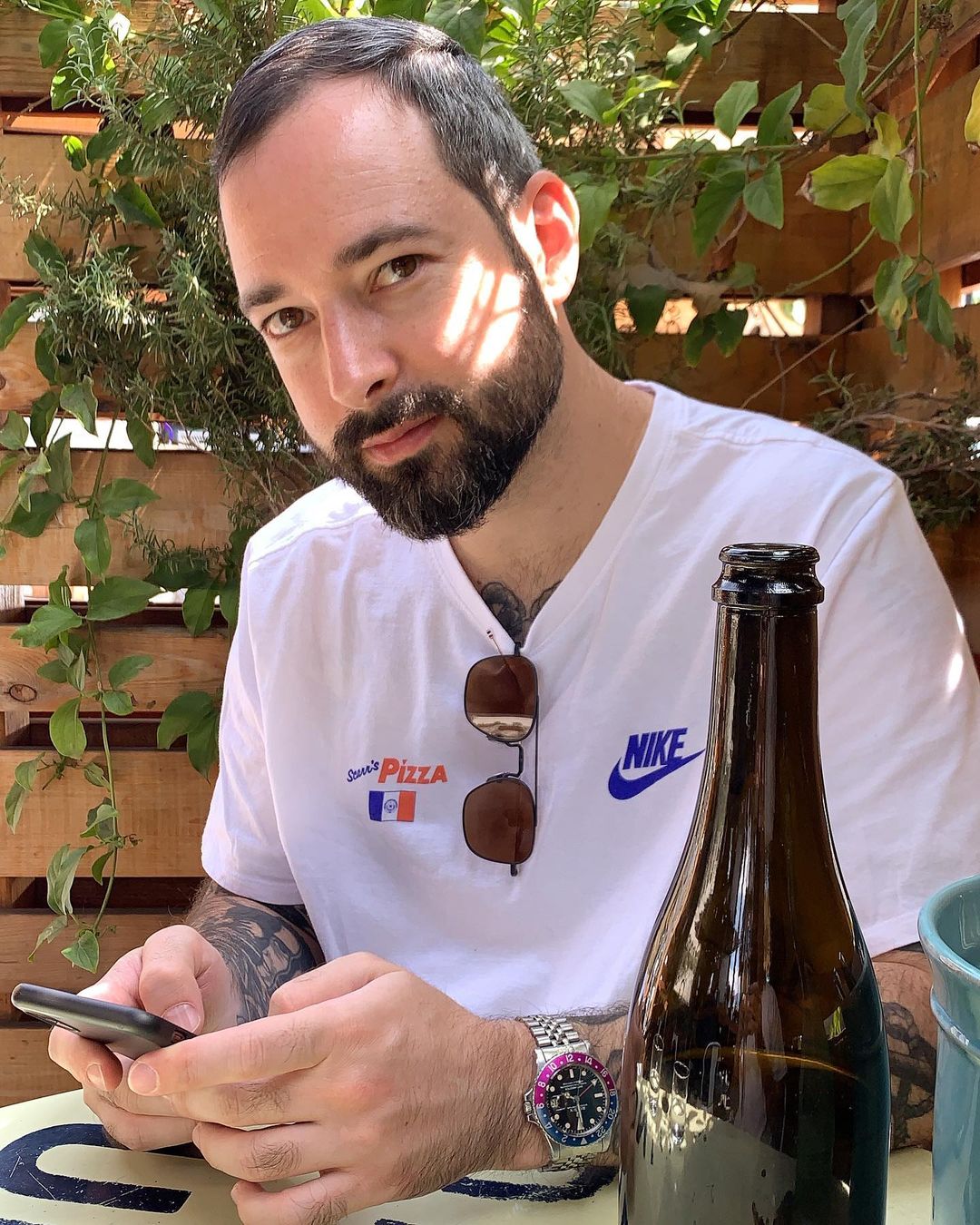
Can we please see what’s on the wrist? That’s the question that catapulted Mike Nouveau into watch stardom, thanks to his penchant for highlighting incredibly rare timepieces across his TikTok account of more than 400,000 followers. When viewing Nouveau’s attention-grabbing video clips—usually shot in a New York City neighbourhood—it’s not uncommon to find him wrist-rolling some of the world’s rarest timepieces, like the million-dollar Cartier Cheich (a clip he posted in May).
But how did someone without any previous watch experience come to amass such a cult following, and in the process gain access to some of the world’s most coveted timepieces? Nouveau admits had been a collector for many years, but moved didn’t move into horology full-time until 2020, when he swapped his DJing career for one as a vintage watch specialist.
“I probably researched for a year before I even bought my first watch,” says Nouveau, alluding to his Rolex GMT Master “Pepsi” ref. 1675 from 1967, a lionised timepiece in the vintage cosmos. “I would see deals arise that I knew were very good, but they weren’t necessarily watches that I wanted to buy myself. I eventually started buying and selling, flipping just for fun because I knew how to spot a good deal.”
Nouveau claims that before launching his TikTok account in the wake of Covid-19, no one in the watch community knew he existed. “There really wasn’t much watch content, if any, on TikTok before I started posting, especially talking about vintage watches. There’s still not that many voices for vintage watches, period,” says Nouveau. “It just so happens that my audience probably skews younger, and I’d say there are just as many young people interested in vintage watches as there are in modern watches.”
View this post on Instagram
Nouveau recently posted a video to his TikTok account revealing that the average price of a watch purchased by Gen Z is now almost US$11,000 (around $16,500), with 41 percent of them coming into possession of a luxury watch in the past 12 months.
“Do as much independent research as you can [when buying],” he advises. “The more you do, the more informed you are and the less likely you are to make a mistake. And don’t bring modern watch expectations to the vintage world because it’s very different. People say, ‘buy the dealer’, but I don’t do that. I trust myself and myself only.”
—
Read more about the influencers shaking up horology here with Justin Hast, Brynn Wallner and Teddy Baldassare.
You may also like.
By Josh Bozin
24/07/2024
This Pristine 1960 Ferrari 250 Spider Could Fetch $24 Million at Auction
The car wears the same colours and has the same engine it left the factory with.
Some Ferraris are just a little bit more important than others.
Take, for example, the 1960 250 GT SWB California that RM Sotheby’s is auctioning off during this year’s Monterey Car Week. Any example of the open-top beauty would attract interest, but this one just so happens to be the first one that was built.
The 250 is one of the most legendary series of cars in Ferrari history. Between 1952 and 1964, the company released 21 different 250 models—seven for racetracks, 14 for public roads—of which the “Cali Spider” might be the most well regarded, thanks to its potent V-12 and a Pininfarina-penned design that is one of the most beautiful bodies to grace an automobile. The roadster, which was specifically built for the U.S., made its debut in 1957 as a long-wheel-base model (LWB), but it wasn’t until the SWB model debut in 1960 that it became clear how special it was. This example isn’t just the first to roll off the line. It’s the actual car that was used to introduce the world to the model at the 1960 Geneva Motor Show.
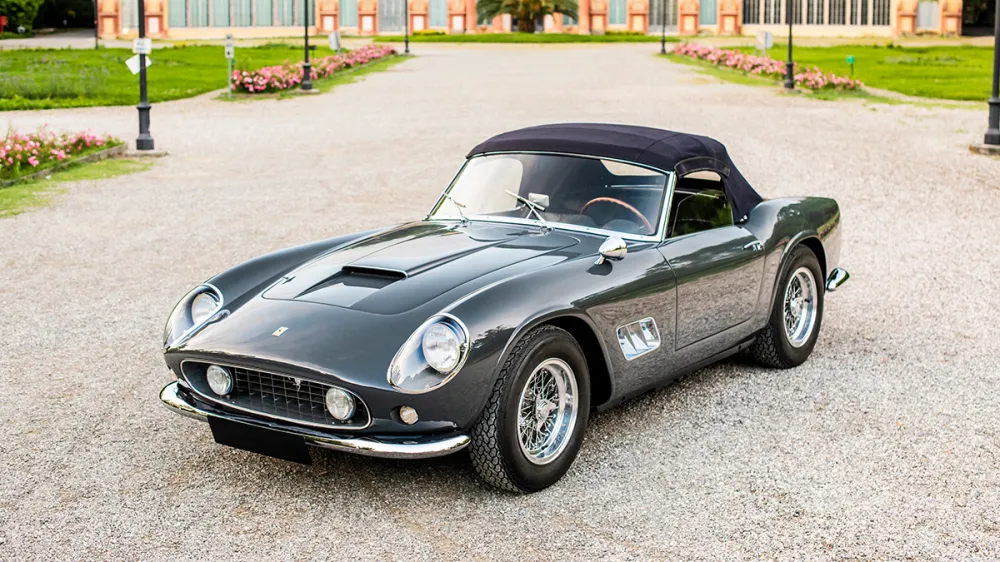
Just 56 examples of the 250 GT SWB California Spider would be built by Scaglietti during the three years it was in production. The first of those, chassis 1795 GT, is finished in a glossy coat of Grigio. The two-door had a red leather interior at Geneva but was returned to the factory and re-outfitted with black leather upholstery before being delivered to its original owner, British race car driver John Gordon Bennet. Six-and-a-half decades later the car looks identical to how it did when it left the factory the second time.
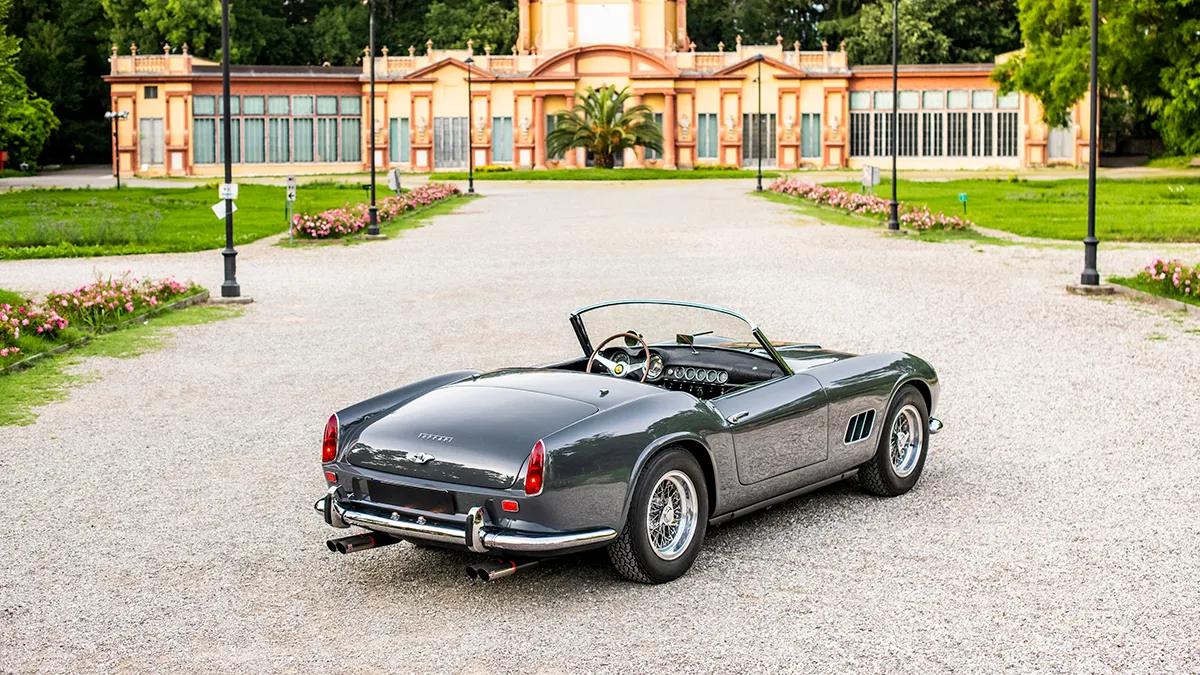
In addition to its original bodywork, the chassis 1795 GT features its original engine, gearbox, and rear axle. That mill is the competition-spec Tipo 168, a 3.0-litre V-12 that makes 196.1 kW. That may not sound like much by today’s standards, but, when you consider that the 250 GT SWB California Spider tips the scales around 952 kilograms, it’s more than enough.
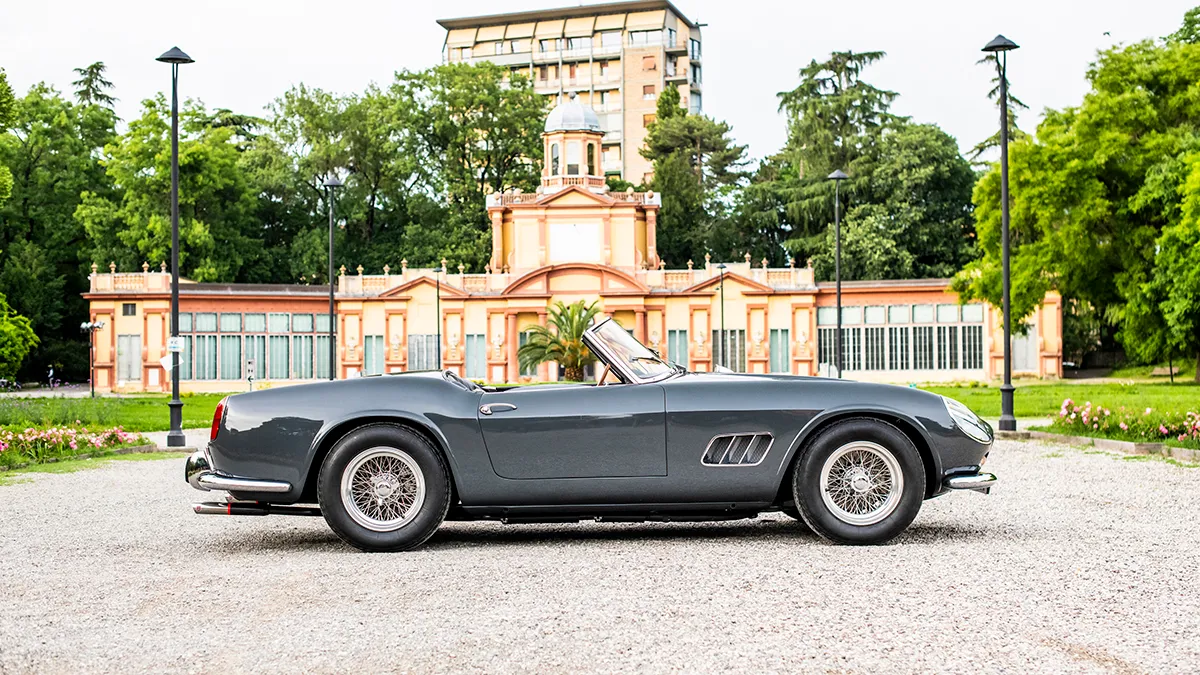
The first 250 GT SWB California Spider is scheduled to go up for bid during RM Sotheby’s annual Monterey Car Week auction, which runs from Thursday, August 15, to Saturday, August 17. Unsurprisingly, the house has quite high hopes for the car. The car carries an estimate of between $24 million and $26 million, which could make it one of the most expensive cars ever sold at auction.
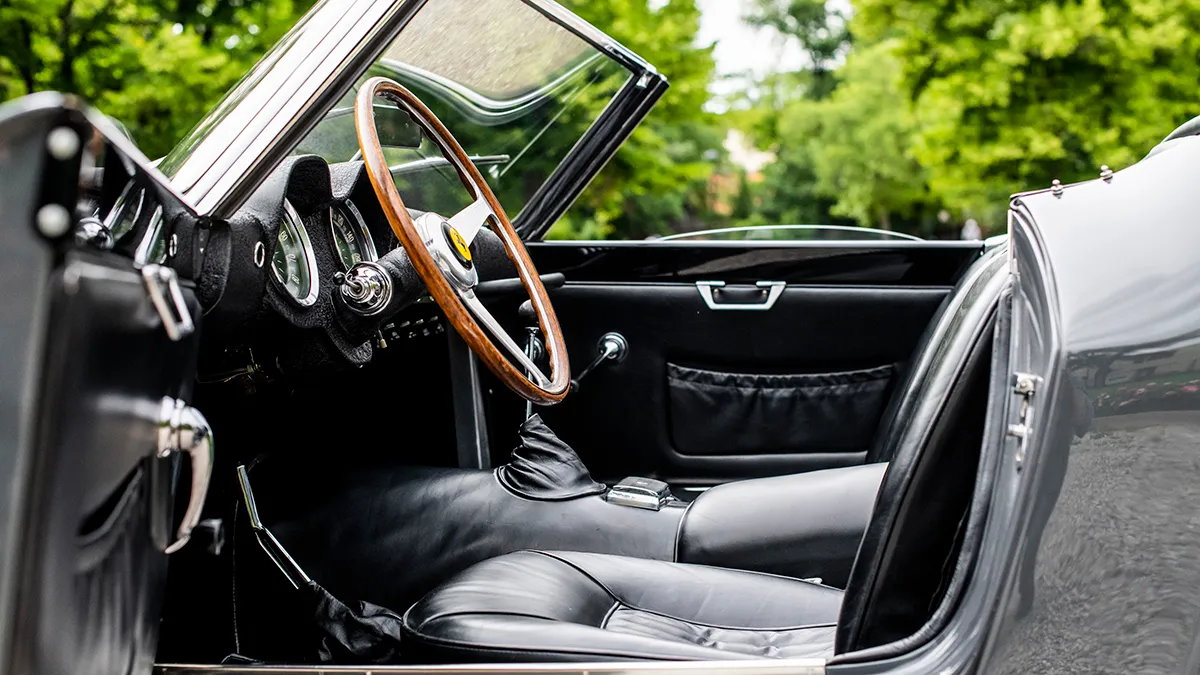
You may also like.
By Josh Bozin
24/07/2024






